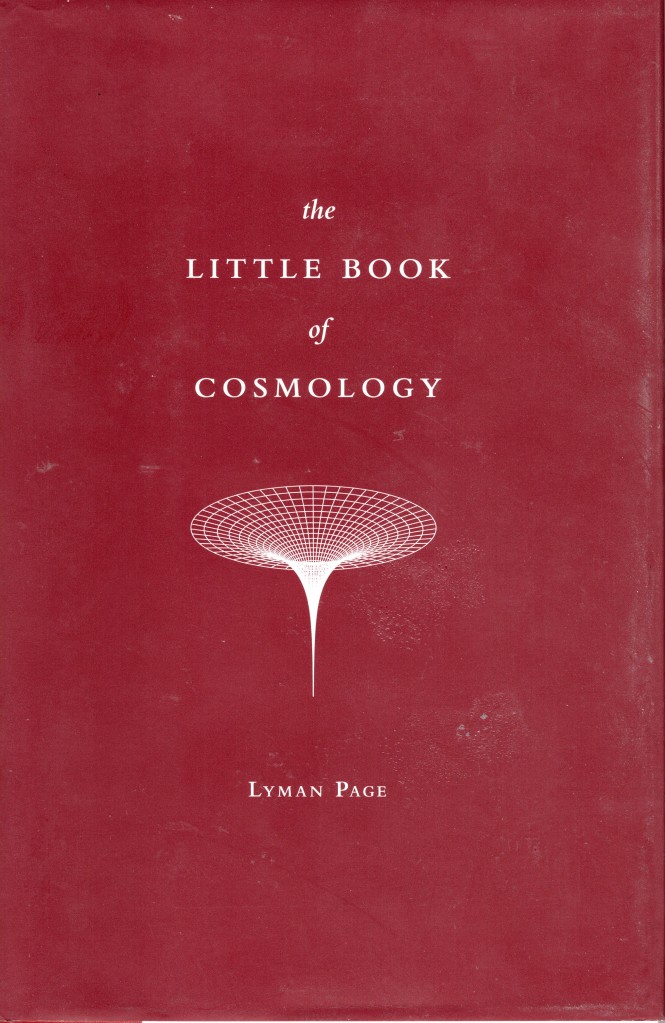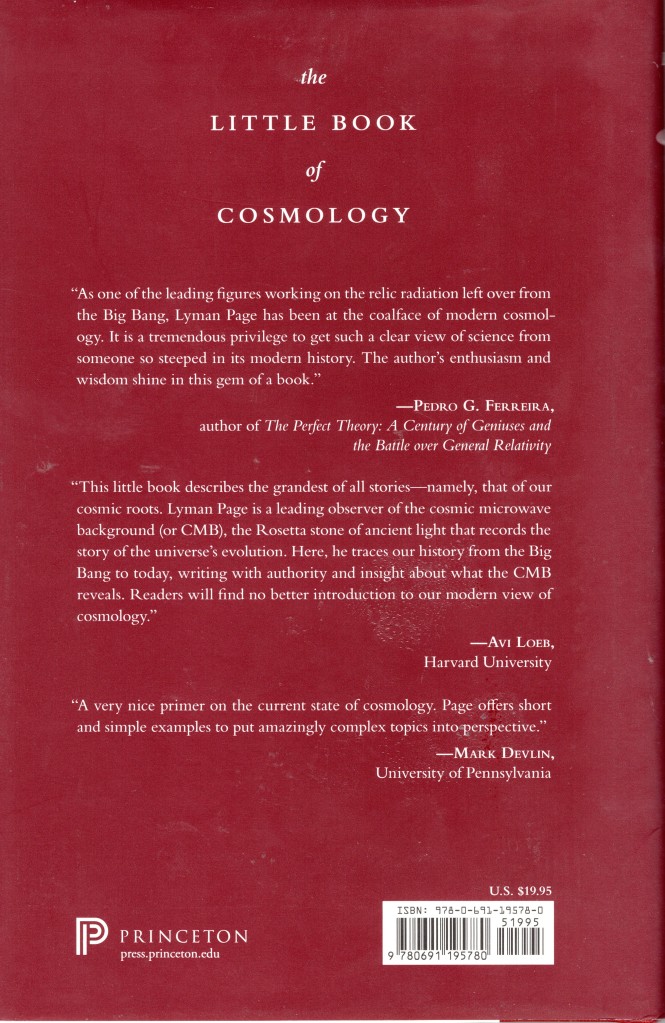Cosmology is the science of the origin and development of the universe, and this post is about a book on Cosmology, The Little Book of Cosmology by Lyman Page. This is a big and, in my opinion, interesting topic. A lot of cosmology is speculative, multiverses, what was before the big bang, has the universe always existed, has there been an infinite number of big bangs, what about conformal cyclic cosmology in which each cycle result in a new big bang (Roger Penrose), what is the future and end of the universe, is the Universe a hologram, is it self-aware, etc.
This book is not focused on scientific speculation but on what we know about the structure of the universe, the big bang and the expansion of the universe, the well understood basics. I think it is amazing how much we can learn from the Cosmic Microwave Background Radiation (CMB).
The goal of this blog is to create a list of what I call super facts. Important facts that we know to be true and yet they are surprising, shocking or disputed among non-experts. Super facts are special facts that a well-informed person may want to know. However, I sometimes create posts that are not super facts but just interesting information, such as this one. The Little Book of Cosmology is a relatively short and easy read. I bought the hardback version of it.
- Hardcover – Publisher : Princeton University Press; First Edition (April 7, 2020), ISBN-10 : 0691195781, ISBN-13 : 978-0691195780, 152 pages, item weight : 2.31 pounds, dimensions : 5.59 x 0.79 x 8.58 inches, it costs $15.39 on Amazon. Click here to order it from Amazon.com.
- Kindle – Publisher : Princeton University Press (April 7, 2020), ASIN : B07Z1DWB4P, 132 pages, it costs $9.99 on US Amazon. Click here to order it from Amazon.com.

Amazon’s description of The Little Book of Cosmology by Lyman Page
The cutting-edge science that is taking the measure of the universe
The Little Book of Cosmology provides a breathtaking look at our universe on the grandest scales imaginable. Written by one of the world’s leading experimental cosmologists, this short but deeply insightful book describes what scientists are revealing through precise measurements of the faint thermal afterglow of the Big Bang—known as the cosmic microwave background, or CMB—and how their findings are transforming our view of the cosmos.
Blending the latest findings in cosmology with essential concepts from physics, Lyman Page first helps readers to grasp the sheer enormity of the universe, explaining how to understand the history of its formation and evolution in space and time. Then he sheds light on how spatial variations in the CMB formed, how they reveal the age, size, and geometry of the universe, and how they offer a blueprint for the formation of cosmic structure.
Not only does Page explain current observations and measurements, he describes how they can be woven together into a unified picture to form the Standard Model of Cosmology. Yet much remains unknown, and this incisive book also describes the search for ever deeper knowledge at the field’s frontiers—from quests to understand the nature of neutrinos and dark energy to investigations into the physics of the very early universe.
This is my five star review for The Little Book of Cosmology
What the Cosmic Microwave Background (CMB) can tell us
This is a short book describing the evolution of the Universe since the Big Bang and its composition. How do we know all this stuff? The Cosmic Microwave Background (CMB) can tell us a lot.
The CMB is a black body radiation remnant from the time (400,000 years after the Big Bang) when the Universe had cooled enough to allow the formation of hydrogen atoms and the decoupling of photons from electrons so that they could roam free.
CMB is in itself evidence for the Big Bang but in addition we get additional information from the minor anisotropy and polarization of the CMB, and add the composition of the elements (hydrogen, helium, lithium, and heavier elements), redshifts of galaxies, gravity lensing, and we can tell quite a bit about the evolution of the Universe and where it is heading.
It’s fascinating science detective work. This eventually leads to the Standard Model of Cosmology, which is something I’ve never heard of before, but it’s cool.
I found the facts about the size and age of the Universe, the early giant stars in the Universe, dark energy and dark matter, very interesting. The book is filled with basic and fascinating facts that I did not know. Because of the CMB (rather than particle accelerator experiments) we know roughly the mass (rest mass) of neutrinos.
We know why dark energy can’t be space dust, or rogue planetoids, or black holes or neutrinos, so what is it? The book explains why it can’t be any of those. There’s a lot we can know because of the CMB and other information, and some things we don’t know. Finding out what we do know was quite exciting and finding out what the mysterious “what we don’t know” was equally exciting. Again, the focus is on CMB and how it is measured, it tells us a lot.
The book is easy to read and require no degree in physics or mathematics. I admit I have a degree in Engineering Physics, and I am also interested in astronomy and cosmology, but I can tell it was light reading. It is a truly popular science book like those that Neil De Grasse Tyson writes, and it was short but very informative. There’s a lot of information you can extract from CMB. It was a fun short read for anyone interested in the mysteries of the Universe.



Really interesting!
LikeLiked by 1 person
Thank you so much Luisa
LikeLiked by 1 person
You’re more than welcome 🙏❣️🙏
LikeLiked by 1 person
I used to read this type of stuff long ago. I should pick it up again.
LikeLiked by 1 person
It seems like I reply to the wrong spot, but I just wanted to say that there are other “the little book” books on these kind of topics, in addtion to Cosmology, there is Black Holes, Exo Planets, String Theory, and also The World’s Littlest Book on Climate: 10 Facts in 10 Minutes about CO2, a very brief but good introduction to climate change.
LikeLiked by 1 person
There are a whole bunch of “the little book” books on these kind of topics, in addtion to Cosmology, there is Black Holes, Exo Planets, String Theory, and also The World’s Littlest Book on Climate: 10 Facts in 10 Minutes about CO2, a very brief but good introduction to climate change.
LikeLike
Interesting indeed, Thomas! Thanks for sharing! Light and blessings to you*
LikeLiked by 1 person
Thank you so much Susana and light and blessings to you
LikeLiked by 1 person
This sounds fascinating, Thomas. I’m headed to Amazon to check it out. Thank you for shining the light on Page’s book. 😊
LikeLiked by 1 person
Thank you so much Gwen. I am going to write a few reviews for some “The Little Book of……” books. The next one will be about exo-planets.
LikeLike
A fascinating topic Thomas and you make it so understandable. I’m more into astrology than astronomy, even though they are closely connected. 🙂
LikeLiked by 1 person
Thank you for your kind words Debby
LikeLiked by 1 person
Thank you for the education. 🙂
LikeLiked by 1 person
Lulu: “Our Dada says this reminds him of something Carl Sagan used to talk about on Cosmos! Whoever and whatever that is …”
LikeLiked by 1 person
Yes Lulu, Dada is right, as always, and Cosmos was a great series and a great book.
LikeLike